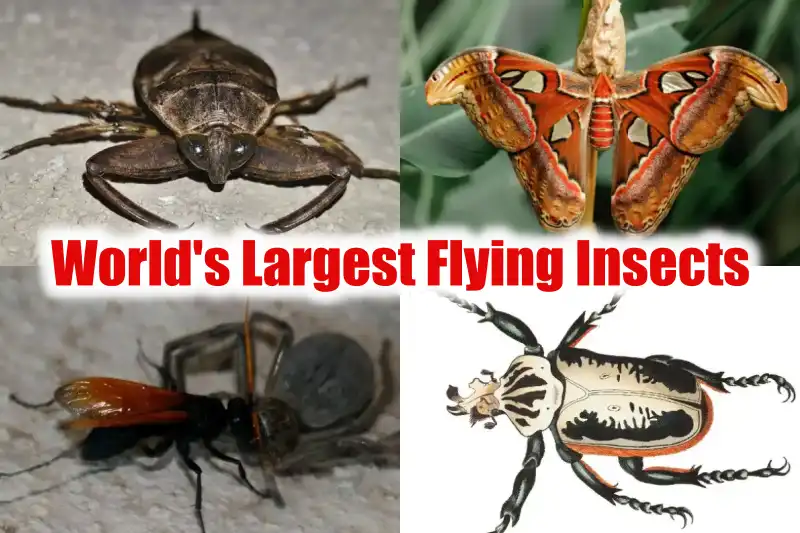Whenever we think about insects, the first thing that comes to mind is their tiny bodies, which are some mm, but if I say there are various insects that can reach a length of 10 cm, What do you say about it? Let’s step into a world where the world’s largest flying insects are living a dominant life in their clan or genus. Here we are going to look at various insects that have a large body and can fly.
So we are welcoming you to a world where the world’s largest flying insects rule. Are you excited? then let’s go.
20 World’s Largest Flying Insects
1) White witch
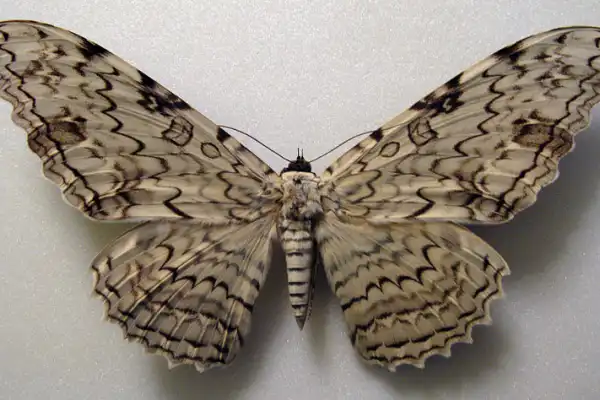
| Scientific name | Thysania agrippina |
| Average size | ~12 cm |
| Geographical location | Uruguay, Mexico, U.S. |
| Identification | black and brown zigzag lines on the wings |
Thysania agrippina is a species of moth in the Erebidae family, known by various names including the white witch, ghost moth, great gray witch, and great owlet moth.
It is considered one of the world’s largest insects, with a wingspan of 30–36 cm. The moth is divided into three parts: the head, thorax, and abdomen.
Its wings display a range of colors, including creamy-white, light brown, gray, and violet-black, creating unique patterns of black and brown lines and white spots.
The moth is found from Uruguay to Mexico and as far north as Texas in the U.S., with no discernible pattern in collection dates, location, or season.
2) Queen Alexandra’s birdwing
| Scientific name | Ornithoptera alexandrae |
| Average size | ~8 cm |
| Geographical location | forests of the Oro Province in eastern Papua New Guinea |
| Identification | Brown wings with white markings and yellow hindwings |
Ornithoptera alexandrae, also known as Queen Alexandra’s birdwing, is the world’s largest butterfly species, with females reaching wingspans slightly exceeding 25 cm to 28 cm.
Females have larger, rounder wings, reaching a wingspan of 25 cm to 28 cm and a body length of 8 cm.
They have brown wings with white markings and yellow hindwings. Males exhibit sexual dimorphism, with long wings, an iridescent bluish-green underside, and a black central band.
Males are smaller than females and have a bright yellow abdomen. The most spectacular form is the atavus, with gold spots on the hindwings.
3) Goliath beetles
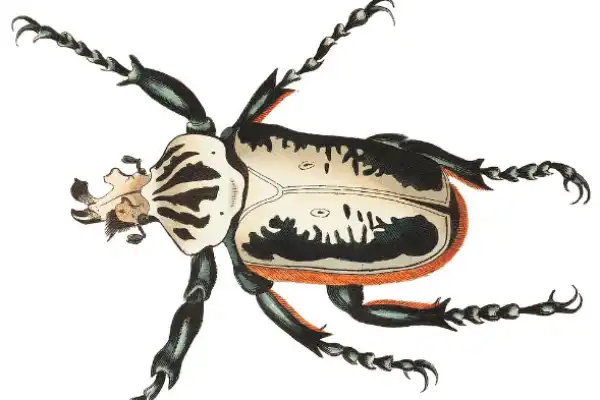
| Scientific name | Goliathus |
| Average size | 6-11 cm |
| Geographical location | Africa |
| Identification | white body with bold black lines on its promontum |
Goliath beetles, named after the biblical giant Goliath, are among the largest insects on Earth, found in tropical forests of Africa. They feed on tree sap and fruit and can reach up to 80-100 grams in the larval stage.
Goliath beetles have a hardened exoskeleton, reinforced forewings, and sharp claws for climbing on tree trunks and branches. Males have a Y-shaped horn on their head, while females have a wedge-shaped head for burrowing.
Goliath beetles are strikingly patterned, with contrasting black vertical stripes on the pronotum and a mix of elytral colors and patterns. Males have a Y-shaped horn for battles, while females have a wedge-shaped head for egg-laying.
4) Atlas Moth
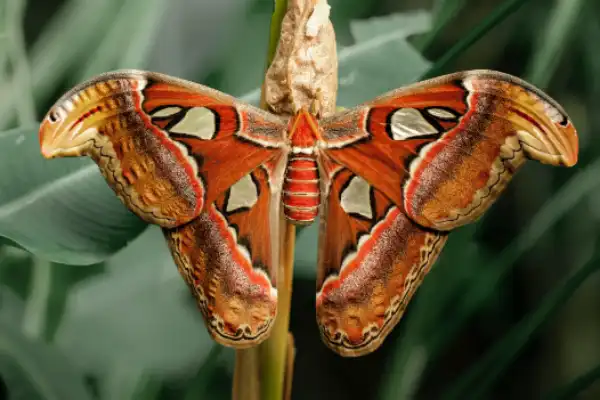
| Scientific name | Attacus atlas |
| Average size | ~11.5 cm |
| Geographical location | Asia |
| Identification | Smaller body than the wings |
Attacus atlas, also known as the Atlas moth, is a large saturniid moth found in Asia’s forests. Its caterpillars pupate and create a papery cocoon, which they attach to a twig using silk. Adult moths emerge from the cocoon after four weeks, depending on environmental conditions.
The moth’s body is small compared to its wings. Talking about their body coloration, they were reddish brown with black, white, pink, and purple lines.
The wings have triangular windows and prominent extensions resembling snakeheads, exaggerated by their movements when facing potential predators.
These are among the world’s largest flying insects, with a wingspan of 24 cm.
5) Hercules beetle
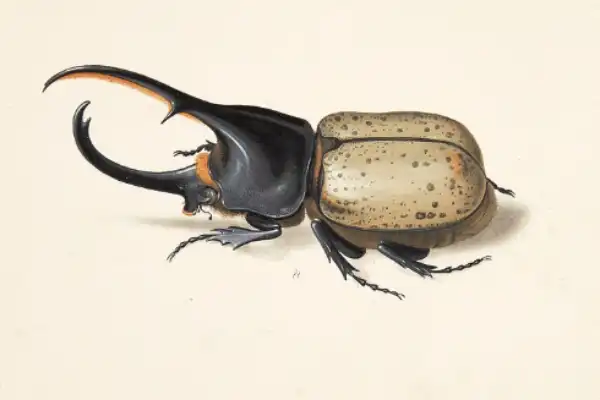
| Scientific name | Thysania agrippina |
| Average size | 5-8.5 cm |
| Geographical location | Southern Mexico, Central America, South America, and the Lesser Antilles |
| Identification | The size of the horn is naturally variable |
The Hercules beetle, a species of rhinoceros beetle, is the longest extant species of beetle and one of the largest flying insects. Its adult body sizes range from 50 to 85 mm in length and 29 to 42 mm in width.
Male beetles can reach up to 173 mm in length, making them the longest species. The horn size is naturally variable, resulting from developmental mechanisms and genetic predisposition.
The beetle is highly sexually dimorphic, with males displaying characteristic horns and a slightly iridescent coloration on their elytra. Females have punctured elytra, usually black.
6) Eastern dobsonfly
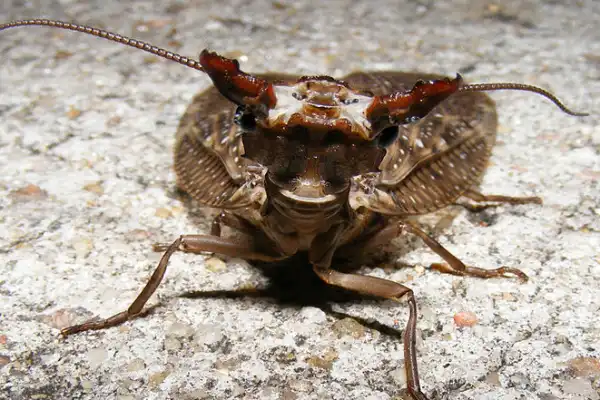
| Scientific name | Corydalus cornutus |
| Average size | 14 cm |
| Geographical location | Eastern North America |
| Identification | Antennae are long and wings are greyish |
The eastern dobsonfly is scientifically known as Corydalus cornutus. The larvae are light brown with microspines, spiracles, and a dorsal plate. The adult dobsonfly is up to 14 cm long with a wingspan of up to 12.5 cm.
The female has short mandibles similar to those of the larva, while the male has sickle-shaped mandibles up to 40 mm long.
These are some of the world’s largest flying insects. They have antennae that are long and segmented, and their wings are grayish-translucent and mottled with white dots.
7) Titan beetle
| Scientific name | Titanus giganteus |
| Average size | ~16.7 cm |
| Geographical location | Venezuela, Colombia, Ecuador, Peru, the Guianas, and north-central Brazil |
| Identification | Blackish brown body |
The titan beetle is a Neotropical longhorn beetle, the sole species in the genus Titanus, and one of the largest known beetles. Its largest specimen is 16.7 cm in length, comparable to giant Fijian beetles and Hercules beetles. Adult titan beetles search for mates via pheromones while in flight.
Larvae feed inside wood and decaying wood below the ground. Boreholes created by titan beetle larvae fit grubs over two inches wide and possibly one foot long.
Adults defend themselves with hissing, biting, sharp spines, and strong jaws.
8) Tarantula hawk
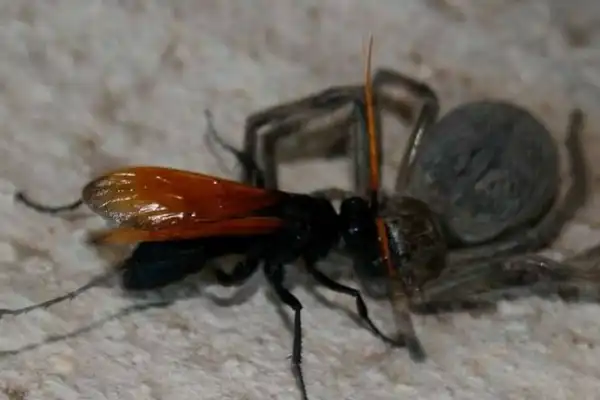
| Scientific name | Pepsis marginata |
| Average size | ~6.5 cm |
| Geographical location | South and Central America and in the southern United States |
| Identification | Dark brown color and banded raptorial legs |
Tarantula hawks are spider wasps that prey on tarantulas, belonging to the Pepsis and Hemipepsis genera. They are one of the largest parasitoid wasps, using their sting to paralyze prey before dragging it to a brood nest for living food.
These wasps, which can grow up to 6.5 cm long, have blue-black bodies and bright, rust-colored wings. Their long legs have hooked claws for grappling with victims.
9) Giant Water Bug
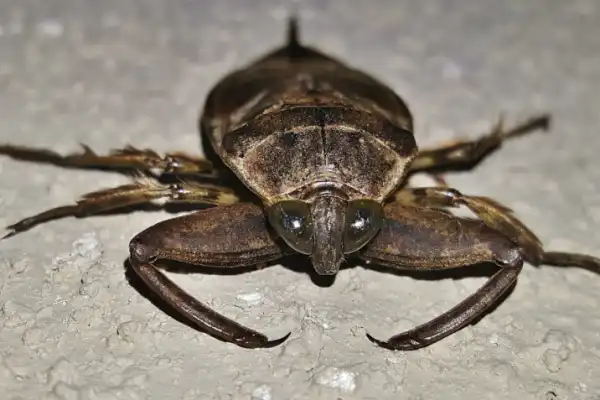
| Scientific name | Lethocerus americanus |
| Average size | 5-7 cm |
| Geographical location | North America and Minnesota |
| Identification | Dark brown color and banded raptorial legs |
The giant water bug is scientifically known as Lethocerus americanus. This is the world’s largest flying insect species and has a large predatory insect, measuring 2–3 inches in length.
Its dark brown color and banded raptorial legs make it one of the largest insects in North America and Minnesota. Known as “alligator ticks,” they can be mistaken for cockroaches due to their tick-like appearance.
They lack jaws or mouthparts for chewing and instead have a needle-like rostrum that they pierce through their prey.
10) Gauromydas heros
| Scientific name | Gauromydas heros |
| Average size | ~7 cm |
| Geographical location | Brazil, Bolivia, and Paraguay |
| Identification | The wing membrane is whitish, brown, or orange |
Gauromydas heros is a giant fly species in the Mydidae family, the largest of the Diptera order. With a wingspan of 10 centimeters, it can reach 7 centimeters and has a whitish, brown, or orange wing membrane.
Larvae feed on immature insects in ants’ nests, and mature larvae create a pupation chamber in the soil before emerging.
11) Asian giant hornet
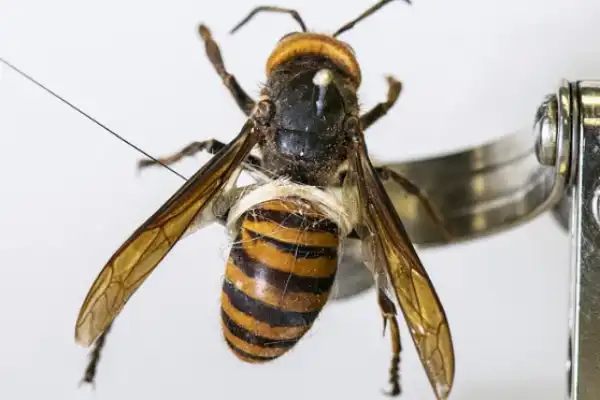
| Scientific name | Vespa mandarinia |
| Average size | 3-5 cm |
| Geographical location | Asia, and North America |
| Identification | Antennae are brown with a yellow-orange base |
The Asian giant hornet, also known as the Japanese giant hornet, is the world’s largest hornet. The hornet’s head is light orange, its antennae are brown with a yellow-orange base, and its eyes and ocelli are dark brown to black.
Its thorax is dark brown, and its fore legs are brighter than the mid and hind legs. The abdomen alternates between bands of dark brown or black and a yellow-orange hue. Its stinger is typically 6 mm long and can kill humans in cases of multiple hornets stinging simultaneously.
12) Common cockchafer beetles

| Scientific name | Melolontha melolontha |
| Average size | 5-7 cm |
| Geographical location | Europe |
| Identification | Large and bulky body |
The common cockchafer, also known as the Maybug, Maybeetle, or doodlebug, is a European scarab beetle species in the Melolontha genus. It feeds on plants and is a major agricultural pest.
Adults have brown elytra with a black thorax and black and partly white undersides. Larvae are white with an orange head. Male cockchafers have seven leaves on their antennae, while females have only six.
13) Actaeon beetle
| Scientific name | Megasoma actaeon |
| Average size | 5-13 cm |
| Geographical location | Bolivia, Brazil, Colombia, Ecuador, Mexico, French Guiana, Guyana, Panama, Peru, Suriname, and Venezuela |
| Identification | Black dorsal |
The Actaeon beetle is a large rhinoceros beetle in the Scarabaeidae family, measuring 5-12 cm in body length. Males can grow up to 13 cm long by 4 cm thick. The dorsal surfaces are glabrous and black, while the legs are powerful with large tarsal claws. Males have horn-like appendages on the pronotum and head, while females have rugose pronotum and elytra.
14) Blue-winged helicopter
| Scientific name | Megaloprepus caerulatus |
| Average size | ~19 cm |
| Geographical location | Central and South America |
| Identification | Black and brown body |
Megaloprepus caerulatus, also known as the blue-winged helicopter, is a forest giant damselfly found in Central and South America. It has the largest wingspan of any living damselfly or dragonfly, up to 19 centimeters in the largest males.
The adult’s body is dark brown or black with yellowish markings, and the wings are hyaline with a dark blue band on the outer third. Adult lifespans have been recorded as long as 7 months.
15) Common scorpionfly
| Scientific name | Panorpa communis |
| Average size | ~3 cm |
| Geographical location | America, Asia, and Australia |
| Identification | pale color wings with black patches |
Panorpa communis, also known as the common scorpionfly, is a species of scorpionfly with a black and yellow body, reddish head, and tail. It has a 30-mm body length and a 35-mm wingspan.
The adult insect has a prominent beak and the shortest abdominal segment in the female. The larva, resembling a caterpillar, grows up to 20mm long and has three pairs of thoracic legs and eight pairs of prolegs. It is not a stinger.
16) Giant stonefly
| Scientific name | Pteronarcys californica |
| Average size | ~5 cm |
| Geographical location | U.S. and Canada |
| Identification | Bright orange abdomen |
Pteronarcys californica is a giant stonefly and salmon fly species in the Pteronarcyidae family. It is an important aquatic insect for fly anglers, with many nymph and adult fly patterns imitating its behavior.
The nymphs, or larvae, can grow to over 5 cm and are detritivores, eating partially broken downstream debris. Adults are large, with bright orange abdomen, leg joints, and thorax joints. They carry eggs at the end of the abdomen, resembling orange salmon eggs.
17) Wallace’s giant bee
| Scientific name | Megachile pluto |
| Average size | 2.3-3.8 cm |
| Geographical location | Indonesia |
| Identification | Gain jaws |
Wallace’s giant bee, also known as Megachile pluto or raja ofu, is a large resin bee found in Indonesia. With a wingspan of 63.5 mm (2.5 in), it is the largest known living bee species.
The species exhibits strong sexual dimorphism, with females reaching 38 mm (1.5 in) and males only growing 23 mm (0.9 in). M. pluto is believed to be the largest living bee species.
18) Giant scoliid wasp
| Scientific name | Megascolia procer |
| Average size | ~5 cm |
| Geographical location | Asia |
| Identification | Wings are brown with blue iridescent reflections |
Megascolia procer, also known as the giant scoliid wasp, is a large tropical wasp found in Asia. It is one of the world’s largest wasps, with a wingspan of 11.6 cm.
The body is primarily black with yellowish markings, while the wings are brown with blue iridescent reflections. The wasp’s size and appearance make it a significant species in the Scoliidae family.
19) Central American giant cave cockroach
| Scientific name | Blaberus giganteus |
| Average size | 7.5-10 cm |
| Geographical location | Mexico, Guatemala, Panama, Colombia, Ecuador, Venezuela, Costa Rica, Brazil, Trinidad and Tobago, Cuba, Hispaniola, Guyana, Suriname, and French Guiana |
| Identification | flattened bodies and brown with black markings |
Blaberus giganteus, also known as the Central American giant cave cockroach or Brazilian cockroach, is a large cockroach native to the Neotropical region. It is one of the world’s largest, with males reaching up to 7.5 cm and females 10 cm.
The cockroaches are lightly built with flattened bodies, brown with black markings, and have a wingspan of around 15 cm. Both males and females have paired appendages, with males having styli. Adults have two pairs of wings folding back over the abdomen.
20) Blue eyes lacewing
| Scientific name | Nymphes myrmeleonides |
| Average size | ~ 4 cm |
| Geographical location | New South Wales and Queensland |
| Identification | Whole pale body |
Nymphes myrmeleonides, also known as the blue eyes lacewing, is an Australian insect in the Neuroptera order. Found in New South Wales and Queensland, it has a body length of up to 4 cm and a wingspan of up to 11 cm. Its larvae resemble antlions and build pit traps.
Conclusion:
These are some of the world’s largest flying insect species that you haven’t seen normally in your surroundings. If you want to know more about the animal kingdom, keep looking for it on HowItSee.
Reference:
- Wikipedia
- atozanimalia
Also Read:

As a content writer, I like to write about different niches. I have a curiosity about nature and animals. And like to learn about them. Through my writing, I like to share my experience and knowledge with you. I hope you are enjoying it too.
